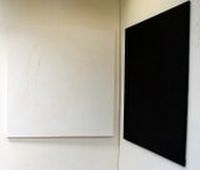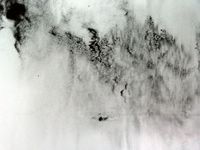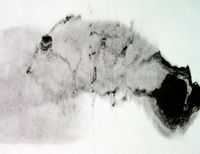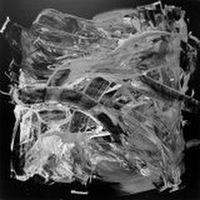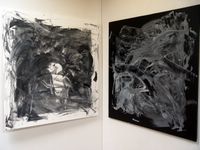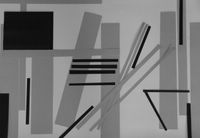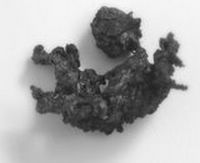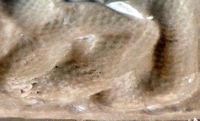Thursday, November 30, 2006
Tuesday, November 28, 2006
dada or it's not over until it's over
By Catherine Field
Monday, November 27, 2006
inchoate (teddybears in blancmange).....complete
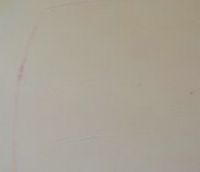
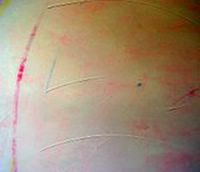
whats going on here?
the picture below is the enhanced version of the one above.
the computer tries to make sense or improve on the original. The reality when viewing the original is that all the colours are present and affecting yet there is white light reflecting off the surface ( which is very very smooth, being thick with talcuum dust, scrapped back)
subverting the obvious functional engagement
creating transparency/opacity ( obscurity of meaning)
undermining the easy relationship between viewer/object
I spend time experimening with the camera photographing surfaces.
inchoate (nemesis) complete

100cm x 100cm. Coal dust, acrylic housepaint, india ink.
I said it would be difficult to photograph. Very difficult. I will keep trying ( learning).
This atempt is enhanced by digitally sharpening the image, a lot. Does give an impression of the surface quality of the painting. The coal dust in the paint is very very absorbant of light, but it's in there.
Fantastic process. 4 pieces in this series, all working with black and white, hard to say which I like the most. The white has so much soft quality..the black is harder but deeper....
the learning is to do with colour, reflection/reflective quality, light being absorbed and the problems for the viewer. I was pleased to be able to stick it out and do these pictures, figuring it has all been done before, yet I enjoyed my own journey there. I can see that I learnt a lot about colour and contrast and all this going on without figure and ground. It was particularily interesting/pleasing/rewarding the space the paintings physically opened up just being painted/exisiting. Viewing each piece is a deepening moment, looking into the space created.
I remain drawn to that process. Stripping down what is superflous to the process of engagement.
How little is essential, what is essential....what happens....?
Friday, November 24, 2006
inchoate (nemesis) incomplete
1000mm x 1000mm
coal dust, black acrylic house paint on stretched canvas
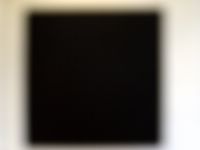
The definition of black in the Oxford English Dictionary is as follows: 'Black; The proper word for a certain quality practically classed among colours, but consisting optically in the total absence of colour due to the absence or total absorption of light as its opposite white, arises from the reflection of all the rays of light' . Colour as a thing in itself, as a certain wavelength is without much meaning. When one considers that everyone perceives colour in a similar way, nonetheless culturally everyone is different and how they respond to colour intellectually can vary greatly.
what's going on here?
black in black on black. 4 layers of black with coal dust and still it reflects light where ever it gets onto the surface but I think the billions of particles of coal crystal are doing something to the surface. Photographing this phenomena is going to be a challenge.
coal dust, black acrylic house paint on stretched canvas

The definition of black in the Oxford English Dictionary is as follows: 'Black; The proper word for a certain quality practically classed among colours, but consisting optically in the total absence of colour due to the absence or total absorption of light as its opposite white, arises from the reflection of all the rays of light' . Colour as a thing in itself, as a certain wavelength is without much meaning. When one considers that everyone perceives colour in a similar way, nonetheless culturally everyone is different and how they respond to colour intellectually can vary greatly.
what's going on here?
black in black on black. 4 layers of black with coal dust and still it reflects light where ever it gets onto the surface but I think the billions of particles of coal crystal are doing something to the surface. Photographing this phenomena is going to be a challenge.
Thursday, November 23, 2006
coal dust drawings-primal dust
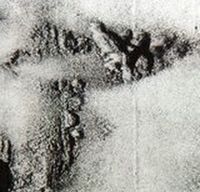
coal dust and newsprint 300mm x 300mm
whats going on here? photography.
Today I set out to make some coal dust, very fine dust, sieved many times to add to my black paint for the final of the 'inchoate' series, called nemesis. The ust itself is a fascinating and mysterious force. I played around with it and photographed the results.
What struck me about this operation was how tone, figure, ground, shadow/ light and ultimately metaphor all emerged quite spontaneously from the process.
Thursday, November 16, 2006
inchoate (teddybears in blancmange).....incomplete
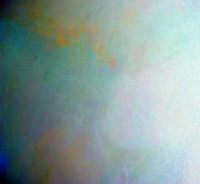
this is the underpainting process, photographed and digitalized ( saturated)
1000x1000mm
india ink, talcum and acrylic.
what colour is white and so on. I'm mixing white with a drop of india ink, blue, yellow, red and painting on in thin glazes/films creating transparencies

this is the same support with another layerof paint applied.
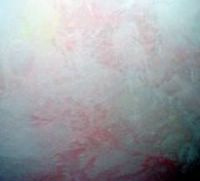
and the final coat
Friday, November 10, 2006
Thursday, November 09, 2006
Saturday, November 04, 2006
verb list
U B U W E B :: Richard SerraSERRA: When I first started, what was very, very important to me was dealing with the nature of process. So what I had done is I'd written a verb list: to roll, to fold, to cut, to dangle, to twist...and I really just worked out pieces in relation to the verb list physically in a space. Now, what happens when you do that is you don't become involved with the psychology of what you're making, nor do you become involved with the after image of what it's going to look like. So, basically it gives you a way of proceeding with material in relation to body movement, in relation to making, that divorces from any notion of metaphor, any notion of easy imagery.
Friday, November 03, 2006
Thursday, November 02, 2006
moulding and waxing
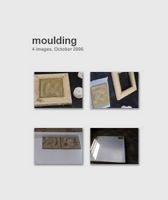
100 tiles of 100m x 100mm under way. 2 done.
here is a list of operations ( verbs)
rolling/casting/moulding/waxing/dipping/stamping/printing...... more as they emerge.
It seems to be tempting or testing fate to talk about the end when I have just begun. Many hours thinking and staring off into space and talking to Audrey about the idea.
The whole process is experimental, never done this before. However I have a clear idea of what could 'be there' when it is finished. Each step, each operation is a work in itself.
Today I finalized the ultimate process for each individual tile by diping the final piece in hot wax and hermetically sealing it off. This will stabilize the collection as it grows to it's full number, no shrinkage. I see now that I can control that process by perforating the wax barrier.....
eventually 100 tiles will have plaster poured over them to a depth of 20mm.
And on it goes.
Have to make one first.
